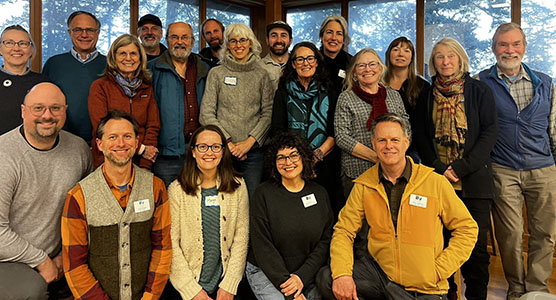— by Matthew Gilbert, Orcas Issues reporter —
Nearly 200 people packed the Orcas High School cafeteria on July 17 to participate in what was titled a “Community Conversation on Vacation Rentals (VR).” The event was organized by a diverse group of citizens who have been working for several months on how to raise awareness on the impact that short-term rentals are having both on Orcas Island and the County at large.
VR Work Group Convener Yonatan Aldort got things started with a passionate statement of his belief in housing as a “basic right and need” and that something in our community is “very wrong.” Just in the last few years, he said, “I’ve had to bear witness to good people leaving as a burgeoning VR market keeps removing residences from the inventory. It’s an embarrassment and an outrage!”
While a member of the EPRC (Eastsound Planning Review Commission), Aldort proposed a 12-month moratorium on new vacation rental permits in the Eastsound Subarea. It was unanimously approved (with one abstention) and presented to the County Council as a formal resolution. As Aldort recalled, the Council quickly dismissed it because, “the impact of VRs is unclear. The evidence is lacking.” So Aldort and a group of others set out to build their case.
The first part of the workshop was just that: A summary of best efforts to compile and make sense of the available data. After Aldort handed the baton to moderator Diane Berreth, she introduced Joe Symons, long-time islander and database sleuth who synthesized public data compiled by the County to come up with some preliminary trends and observations.
“This data only addresses legally permitted VRs,” he began. “There is still insufficient data on VRs overall to make thoughtful decisions.” (And by the way, there is no restriction on the number of VR permits the County can issue.)
Nevertheless, what he came up with was eye-opening. For example:
- 505 of 3180 parcels on Orcas (about 16%) have a VR permit. Of the 1,115 VR permits in the County, almost half are on Orcas. There is no data on illegal VR accommodations.
- The County officially shows a steady decline in the issuance of VR permits and, looking ahead to 2036 (the current GMA/Comp Plan timeline), projects no increase in annual issuances.
- According to County data compiled by Symons, however, the annual number of permits issued since 2010 has tripled, from 20 in 2010 to 70 in 2017. (2010 is post-Recession and also coincides with the emergence of Airbnb as a VR property disruptor.)
- Over half of all VR permits have been issued to people who don’t live in SJC, a rate that is also going up.
- Current trends suggest that as many as 80% of all new housing starts may be issued a VR permit.
- Applicant data collected by the County during the permitting process has huge gaps, making it very difficult to understand who and what is being permitted. Some of that data is available in other databases, a point that Economic Community Development Director Erika Shook addressed at the Planning Commission meeting on the 17th (a summary of which will be included in an upcoming article).
Symons was followed by Ryan Page, the County’s Affordable Housing Coordinator, who counted down a list of by now familiar characteristics of the county’s housing crisis:
- A $633k median home resale price.
- A $34.7k annual salary.
- 3,000 “cost-burdened” households.
He concluded by stating that the issue is not so much a shortage of housing as a shortage of available housing. Of the 13,912 housing units in the County, 7,718 (55%) are occupied and 45% are considered “vacant.” That category is further subdivided into seven other classifications such as “For rent,” “For sale only,” and so on. By far the largest classification within the vacant category is “For seasonal, recreational, or occasional use” – 85%.
At the same time, he was encouraged by the recently passed SJC “Home Fund,” a real estate excise tax (REET) that is expected to generate $1.3M in 2019.
Suzanne Olson put a human face on the VR issue as a local who’s been using Airbnb since 2012 to rent a room in her home “because we need the money to stay on the island.” She went on to say that she and her husband work multiple jobs, are very involved in the community, and “like meeting our guests. We’ve never had a problem.” Her story put an exclamation point on the difference between off-island, corporate, absentee property rental ownership and the role VRs can play when directly controlled by owner-occupied residents.
The final presenter was Jennifer Barcelos, staff attorney for Friends of the San Juans. Barcelos has been studying the experience of other communities both large and small around the world that have been affected by the VR virus and how they’ve responded. From Amsterdam and Dublin to Nashville and San Diego, local governments have enacted everything from limiting the yearly number of VR nights to limiting them in residential areas to shutting down the permitting process entirely.
Barcelos also mentioned a recent article in Harvard Business Review titled, “When Airbnb Listings in a City Increase, So Do Rent Prices.” It concluded that “the growth in home-sharing through Airbnb contributes to about one-fifth of the average annual increase in U.S. rents” and that “because of Airbnb, absentee landlords are moving their properties out of the long-term rental and for-sale markets and into the short-term rental market.” Another recent article in Wired, “Inside Airbnb’s ‘Guerilla War’ Against Local Governments,” investigated the local tax implications of the Airbnb business model.
It should also be noted that Airbnb is not the only property rental company disrupting local economies. [Though its impact is considerable – just check out the graphic in this Seattle Times article from July 13.] VRBO, Flipkey, Vacasa, and others are all at play here in the San Juans, along with absentee owners for whom obtaining a VR permit is little more than a formality – the process itself is pretty simple. One wonders if this is the case for the recently arrived 4,000-sq.-ft. structure looming over Orcas Road just south of Eastsound. Rumor has it that the house, referred to by some as “the gray whale,” is in line to be permitted as a VR. There is little to stop that from happening, but is it appropriate? Then again, standing alone on that particular stretch of Orcas Road, maybe it is. Now imagine half-a-dozen along that same stretch.
Attendees then met in facilitated small groups to talk about their personal experiences with VRs, the pros and cons, and what, if anything, should or could be done. Key takeaways reported by the groups included concerns regarding infrastructure saturation, economic speculation, and loss of rural integrity. There were also calls for more data with a focus on clarifying the difference between resident and non-resident ownership impacts.
The gathering highlighted tangible frustration among a sizeable segment of the Orcas Island community and one wonders how – or if – the County will respond. Repeated emails to Councilman Rick Hughes, who did attend the meeting, went unanswered. The topic did come up at the Planning Commission meeting mentioned above with Orcas residents and commission members Tim Blanchard and Georgette Wong reporting on their experience. That conversation will also be included in a forthcoming article on that meeting.
As for the group that organized the workshop, all of their presentations, along with a consolidated list of those small-group “pros and cons,” will be posted on a soon-to-be announced website. That group also announced a second meeting scheduled for September 25.
**If you are reading theOrcasonian for free, thank your fellow islanders. If you would like to support theOrcasonian CLICK HERE to set your modestly-priced, voluntary subscription. Otherwise, no worries; we’re happy to share with you.**








Thank you Matthew. Please note the following correction. You stated “According to County data compiled by Symons, however, the annual number of permits issued since 2010 has gone up significantly, tripling each year.” This is incorrect. In the 7 year period 2010 to 2017, the number of permits issued annually tripled. There were 20 permits issued in 2010, and 70 permits issued in 2017. The graph I presented shows a pretty consistent trend line during this period. We don’t know if this trend will continue; if it did, then, for example, by 2024 the number of permits issued that year would be 210.
We do not know when our website will be up and running. In the meantime, if someone wishes to see my presentation, s/he can find it at “http://doebay.net/VR/VRTrendsJuly2019.pdf”
Thank you for reporting on this important topic.
Somehow the presentations at this discussion failed to address the new regulations passed by the County Council, which include a process that can hardly be called “simple,” and which requires permits to be renewed every year. There is a full-time enforcement officer now to take complaints about non-permitted rentals and permitted rentals whose renters or owners violate the rules. Several participants were clearly unaware of the Council’s extensive process, including a number of public hearings, that led to this effort, asking “why doesn’t the County regulate vacation rentals?” The County does, and it was listening in 2017-2018 when these issues were fully considered. We are seeing the positive results now.
Also, the “data” regarding the number of vacation rental permits did not take into account the new regulatory system. VR permits are no longer “one and done;” applicants must now renew every year, and every existing permit either had to renew or be extinguished. There appear to be a significant number of permitted properties no longer in the VR business.
Calling a large percentage of the traditional summer homes on the island “vacant” is rather bizarre. Orcas was principally a summer home community after the timber, fruit, and fishing industries failed. The notion that people with homes that they use only in the summer and on holidays are somehow doing damage to the community is ridiculous; they pay full taxes and use fewer services.
Finally, the summary of comments and concerns failed to include numerous questions raised and reported, such as what support exists for the idea that vacation rentals would otherwise be available as affordable rentals? There may be some, but the bulk of the units for vacation rental are way too expensive to be affordable long-term rental housing.
Peg Manning asks: “…what support exists for the idea that vacation rentals would otherwise be available as affordable rentals? There may be some, but the bulk of the units for vacation rental are way too expensive to be affordable long-term rental housing.”
The easy answer is that if the vacation-rental’s price was annualized, rather than spread only over a couple of months, the monthly rent would be more properly affordable to a working family.
Vacation rentals bring cash to the state’s and the county’s government, but that’s not the most important economic issue. The real issue is housing for workers and their families. Thus, the fact that vacation rentals stand vacant for most of the year has become a very serious problem.
That is correct Steve. As a long term islander last year I stopped using a small studio apartment as a short term rental and have been providing year round housing for a school teacher. That has worked out very well for both of us. The teacher is comfortable and happy, My annual income is about the same but now consistent monthly, with a lot less daily apartment cleaning and managing to do. It is good for both of us, and good for the community.
Joe, that data point has been revised. Peg, my impression from talking to several people with permitting experience is that when it comes to the County, getting a VR permit is relatively painless compared to other permits. And, it’s also true that the County is becoming a more aggressive enforcer and VR permit manager, but it’s still pretty easy to get in that game.
I would like to clarify something in relation to Peg Manning’s comment. I believe you’ve misunderstood the extent of the county’s new regulations.
First off, the new regulations state that “Vacation rental permits vested or approved after March 27, 2018, shall expire two years after the date of approval unless the annual certificates of compliance meeting the requirements of subsection (K)(4) of this section are on file with the administrator.”
They also state that permits approved prior to March 27, 2018 are exempt from this requirement. I questioned Erika Shook about this myself while on EPRC and she said that people who didn’t update their certification would be considered in non-compliance and issued warnings or possibly fines, but their permit will not automatically be revoked.
Since March 2018 is less than 2 years ago, any permits approved since then under the new rules have not had enough time pass to face the possibility of revocation.
Furthermore, the annual requirement posed by the county (as well as the initial permitting process) is extraordinarily simple and easy to complete.
So in a nutshell, the widespread non-compliance to the county’s new regs does not change the validity of the data that we currently have on VR permits. It also doesn’t change the clear and continuing growth of permitted vacation rentals over the last decade which shows no signs of stopping.
Finally, in regards to affordable housing, I personally know people who have lost affordable housing to VRs and also who have gained it from illegal VRs that were shut down under the new regulations. There is absolutely a segment of the VR market that constitutes affordable housing. There is also data to support this. Additionally, the Harvard Business Review study referenced in this article established a clear connection between a proliferation of VRs and an increase in home and rent prices across the board.
Identifying the exact extent of these trends in SJC and on Orcas is difficult, but to suggest that there is no impact is ludicrous.
Yonathan–I’m not sure what point you’re trying to make about the new County vacation rental regulations. Every existing permit holder now has to apply for renewal annually. This requires acknowledgment and certification of compliance with the new requirements. Legal due process principles require the County to first notify the non-compliant permit holders and allow them to respond before termination, but termination will occur.
Steve–there are a number of VR scenarios, including owners renting parts of their home, or renting their guest house, or renting out their main house for the season while living in a guesthouse. I don’t see many of them becoming “affordable” housing, both because of costs and because many owners would never enter into long-term rental.
Joe–do the 70 new permits include the new, renewed permits?
Matthew–Not sure why obtaining a permit for vacation rentals shouldn’t be relatively simple. Permitting across the board is expensive, time-consuming, and complicated. If a rental qualifies under the new rules and pays the fee, there’s no reason why it shouldn’t get a permit. And any system that treats summer homes as “vacant” is odd, to say the least. Orcas has always had a large number of family summer homes as part of its community. These aren’t vacation rentals.
This is me slowly falling in love with Peg Manning over coffee. Well, at least her understanding of the history and clarity of the facts of this issue.
Time to put down the pitchforks y’all. Home owners trying to make their economics work are not the Dr. Frankensteins of this story.
Now—back to my latte..
Peace
Steve Henigson- Although you may be correct about the price being “annualized” coming out equal (but only in some cases actually) you fail to take into account the detail that many of these home owners desire to actually come and live in THEIR homes for a part of the year precludes them from renting year round. That and the fact that in many cases year round renters abuse property and are then extremely difficult to evict!
I was forced to pay $7000 to evict a tenant and then work for 50 hours cleaning the mess!
Never again.
Please do not tell me or others what to do with our property that we have worked so hard to own!
Yonatan–I would love to see the data you mention. (“There is absolutely a segment of the VR market that constitutes affordable housing. There is also data to support this.”) In fact, the people with whom I spoke were in agreement concerning the lack of meaningful data about Orcas vacation rentals. Can you point me to it? (I note the $630,000 median home sale value cited by the County housing coordinator.)
Rick Hughes has been working to gather data regarding vacation rentals–data that is not immediately available from the County’s digital records. One proxy for what might constitute “affordable” real property is the assessed value. I’m eager to see what he finds. Again, with a median house resale value of $600,000, it’s difficult to see “affordable.”
I’m not sure that many vacation rental owners would agree that the “annual requirement posed by the county (as well as the initial permitting process) is extraordinarily simple and easy to complete,” though that would be a good thing, in my opinion. We shouldn’t regulate VRs by just making the red tape overwhelming. That’s as irrational as a blanket moratorium. And the rules require compliance with both nuisance (noise, parking, trash) and life safety code rules that appear more stringent than currently applied to rental housing.
Peg as you suggested “One proxy for what might constitute “affordable” real property is the assessed value.” I wrote a very short bit of code which, given the tax ids, accessed the assessors website and extracted the assessed value. 25% of the 846 properties in the data I have are assessed at less than $370K, the median is $515k. The most expensive just under $1M and the least expensive $18k.
Assessed value is only a proxy and I don’t see where/how to get actual market values (for what they are worth, which probably isn’t much).
Unfortunately the County doesn’t seem to be able to keep this data up to date and/or easily accessible: this data is around 8 months old.
Well, Bob, maybe an answer to your own problem with renters, and of others who rent-out their own vacation homes, would be to provide space for a caretaker or caretaker-family.
A small ADU, should the county be so generous as to permit you to provide it, would house a year-’round caretaker (or even a family) who would then control and oversee your property, its renters, and its condition.
I make the assumption that the caretaker need not live rent-free, but rather at a reduced rent, and would also have to find daily paid employment on the island.
So, your property would be protected, and, at the same time, housing would be provided for a necessary worker. Thus, everybody wins.